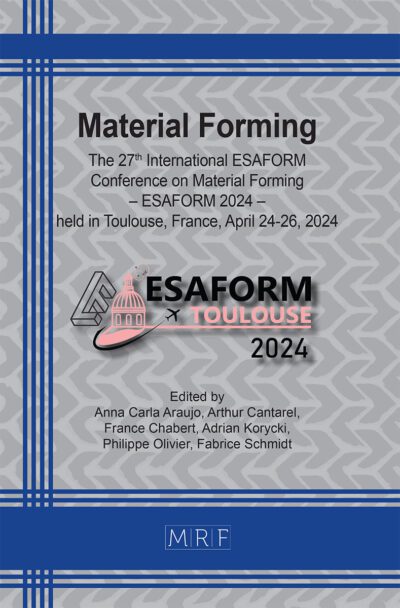Towards an efficient simulation tool for textile modelling at meso-scale
Baptiste LACROIX, Auriane PLATZER, Julien COLMARS, Emmanuelle VIDAL-SALLE
Abstract. Designing and manufacturing composite parts require the knowledge of important topics such as fibre orientation and fibre volume content. Those geometric parameters have an influence not only on the impregnation operation but also on the final mechanical behaviour of the designed component. In the continuity of previous proposals, the present paper deals with improvements of the technique and recent results obtained on the simulation of textile simulations using the 3D solid-beam finite element previously presented using a mesoscopic approach at the reinforcement level.
Keywords
Fibrous Reinforcement, Yarn Modelling, Finite Element, Solid Beam
Published online 5/7/2025, 9 pages
Copyright © 2025 by the author(s)
Published under license by Materials Research Forum LLC., Millersville PA, USA
Citation: Baptiste LACROIX, Auriane PLATZER, Julien COLMARS, Emmanuelle VIDAL-SALLE, Towards an efficient simulation tool for textile modelling at meso-scale, Materials Research Proceedings, Vol. 54, pp 439-447, 2025
DOI: https://doi.org/10.21741/9781644903599-48
The article was published as article 48 of the book Material Forming
![]() Content from this work may be used under the terms of the Creative Commons Attribution 3.0 license. Any further distribution of this work must maintain attribution to the author(s) and the title of the work, journal citation and DOI.
Content from this work may be used under the terms of the Creative Commons Attribution 3.0 license. Any further distribution of this work must maintain attribution to the author(s) and the title of the work, journal citation and DOI.
References
[1] D. Durville, Simulation of the mechanical behaviour of woven fabrics at the scale of fibers. Int J Mater Form. 3 Suppl 2 (2010) 1241–1251. https://doi.org/10.1007/s12289-009-0674-7
[2] G. Zhou, X. Sun, Y. Wang, Multi-chain digital element analysis in textile mechanics. Composites Science and Technology. 64(2) (2004) 239–244. https://doi.org/10.1016/S0266-3538(03)00258-6.
[3] P. del Sorbo, J. Girardot, F. Dau, I. Iordanoff, Numerical investigations on a yarn structure at the microscale towards scale transition. Composite Structures. 183 (2018) 489–498. https://doi.org/10.1016/j.compstruct.2017.05.018
[4] R. Azzouz, S. Allaoui, R. Moulart, Composite preforming defects: a review and a classification. Int J Mater Form. 14 (2021) 1259–1278. https://doi.org/10.1007/s12289-021-01643-7
[5] M. Sherburn, A. Long, A. Jones, J. Crookston, L. Brown, Prediction of textile geometry using an energy minimization approach. Journal of Industrial Textiles. 41(4) (2012) 345-369. https://doi.org/10.1177/1528083711420747
[6] S.V. Lomov, Modeling the geometry of textile composite reinforcements: WiseTex, in: Woodhead Publishing Series in Composites Science and Engineering, Composite Reinforcements for Optimum Performance (Second Edition), Woodhead Publishing, 2021, pp. 199-236. https://doi.org/10.1016/B978-0-12-819005-0.00007-1
[7] Y. Kyosev, Generalized geometric modeling of tubular and flat braided structures with arbitrary floating length and multiple filaments. Textile Research Journal. 86(12) (2016) 1270-1279. https://doi.org/10.1177/0040517515609261
[8] S. Gatouillat, A. Bareggi, E. Vidal-Sallé, P. Boisse, Meso modelling for composite preform shaping – Simulation of the loss of cohesion of the woven fibre network, Composites Part A: App. Sc. and Manuf. 54 (2013) 135-144. https://doi.org/10.1016/j.compositesa.2013.07.010
[9] S. Gao, B. Liang, E. Vidal-Sallé, Development of a new 3D beam element with section changes: The first step for large scale textile modelling. Finite Elements in Analysis and Design 104 (2015) 80-88. https://doi.org/10.1016/j.finel.2015.06.003
[10] E. de Luycker, N. Hamila, Modeling of hyperelastic bending of fibrous media using second-gradient isogeometric analysis: Weaving and braiding applications. Composites Part A: App. Sc. and Manuf. 167 (2023) 107415. https://doi.org/10.1016/j.compositesa.2022.107415
[11] R. Bai, E. Guzman-Maldonado, et al. Influence of in-plane bending behaviour on textile composite reinforcement forming. International Journal of Mechanical Sciences 273 (2024) 109206. https://doi.org/10.1016/j.ijmecsci.2024.109206
[12] B. Lacroix, J. Colmars, A. Platzer, N. Naouar, E. Vidal-Sallé, P. Boisse, A solid-beam approach for mesoscopic analysis of textile reinforcements forming simulation in 27th ESAFORM, Toulouse (France) (2024) 449-456. https://doi.org/10.21741/9781644903131-50
[13] T. Belytschko et al. Finite Elements for Nonlinear Continua and Structures. Wiley (2014). ISBN: 978-1-118-63270-3
[14] M. Brunet, F. Sabourin, Analysis of a rotation-free 4-node shell element. Int. J. Numer. Meth. Engng 66(9) (2006) 1483–1510. https://doi.org/10.1002/nme.1608
[15] A. Charmetant, E. Vidal-Sallé, P. Boisse, Hyperelastic modelling for mesoscopic analyses of composite reinforcements. Composites Science and Technology 71.14 (2011) 1623–1631. https://doi.org/10.1016/j.compscitech.2011.07.004
[16] J.C. Criscione, A.S. Douglas, W.C. Hunter, Physically based strain invariant set for materials exhibiting transversely isotropic behavior, Journal of the Mechanics and Physics of Solids. 49(4) (2001) 871-897. https://doi.org/10.1016/S0022-5096(00)00047-8
[17] M. Salem, E. de Luycker, K. Delbe, M. Fazzini, P. Ouagne, Experimental investigation of vegetal and synthetic fabrics cohesion in order to prevent the tow sliding defect via frictional and pull-out test. Composites Part A: Applied Science and Manufacturing. 139 (2020) 106083. https://doi.org/10.1016/j.compositesa.2020.106083












